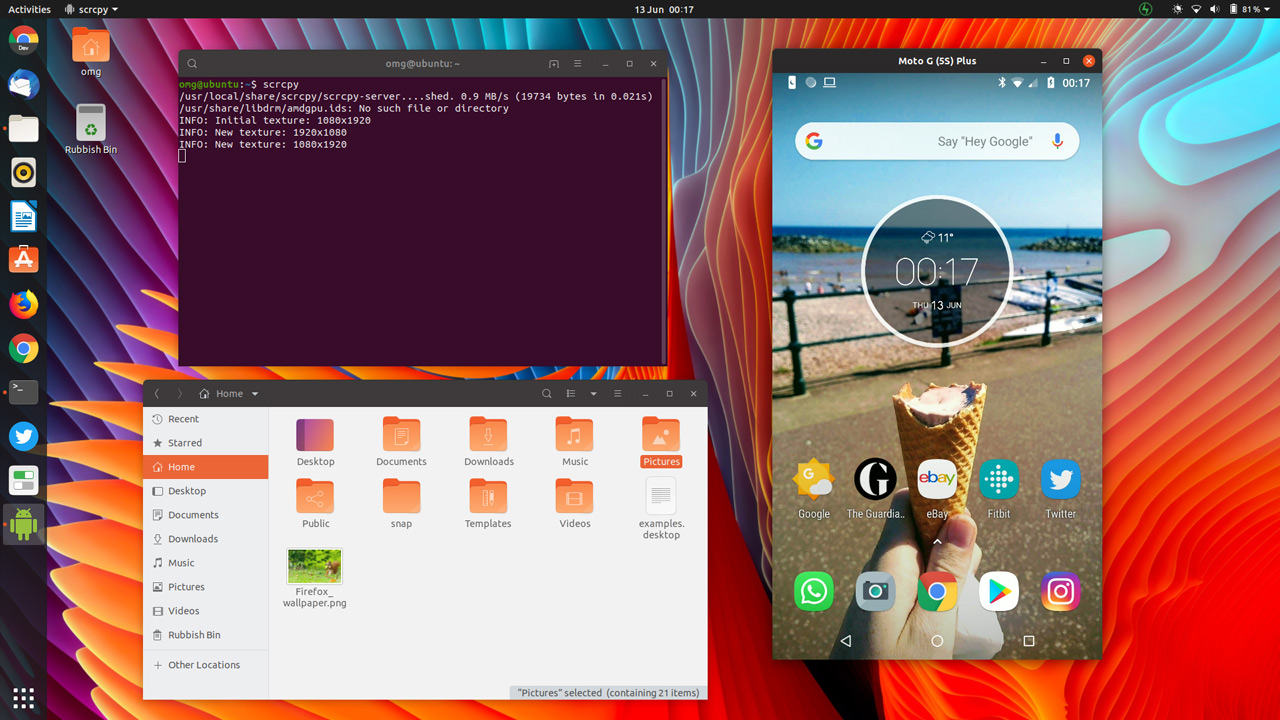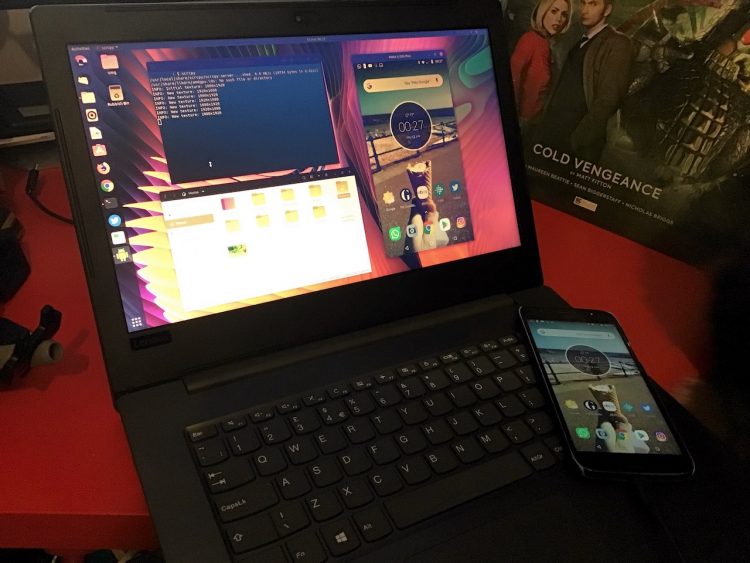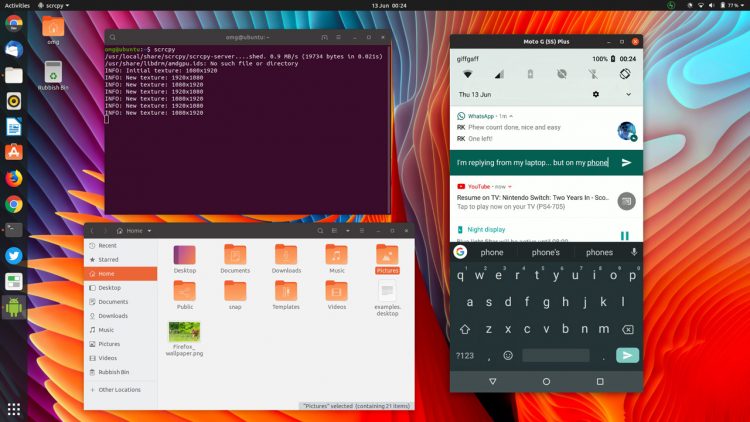Do you want to mirror your Android phone on the Ubuntu desktop, but don’t want to install an app on your phone or sign-up to an expensive service to do it?
Well, you can!
There’s an awesome free, open-source tool designed specifically for the purpose of viewing your phone screen on your laptop or desktop PC.
In this post I tell you about the app, where to download it, and how to use it on Ubuntu & Linux Mint.
Scrcpy: See Your Phone Screen on a PC
Do more than just see your Android phone’s screen on your PC: interact with it using a keyboard and mouse
Scrcpy is the app I’m talking about.
It lets you mirror an Android device to your desktop PC or laptop in free-floating window. It works on Windows, macOS and Linux — all entirely for free!
Want to do more than just see your phone’s screen on your PC?
Scrcpy also lets you interact with your phone using your computer’s keyboard and mouse (or, if you’ve got one, a touchpad or touchscreen).
It’s kinda crazy the opportunities this free app enables.
For example, you can use Scrcpy and your laptop’s full-sized keyboard to tap out a ranty/witty Instagram comment; use your mouse to swipe through Snapchat’s terrible interface; record yourself beating a difficult level in a popular game — whatever you can think of!
Scrcpy is also useful for Android app developers as makes it easier to test, debug, and screencast software without needing to run commands or transfer things across over adb – you can drag and drop .apk files from your desktop to the Scrcpy window to install them!
Versatility is Scrcpy‘s calling card, making it utility that any ardent Android developers should have in their software toolbox. But regular users (like me) will want to play around with it too as it makes interacting with any Android device so easy.
And the fact that it is free, open-source software?
Well, that just adds to its appeal.
Display & Control Android over USB
Scrcpy is created by the team behind Genymotion, a popular Android emulator but it is not an Android emulator. It doesn’t not “install” Android on Ubuntu, virtualise it, make a copy of it, or anything else.
As the Github project page explains, this app is designed to: “…display and control of Android devices connected on USB (or over TCP/IP). It does not require any root access. It works on GNU/Linux, Windows and MacOS.”
This sort of functionality isn’t new. Apps like Vysor and AirDroid also offer Android screen mirroring on a PC, albeit (usually) at a cost.
Scrcpy is 100% free. It gives you a high-resolution “mirror” of your phone’s screen in a floating window. You can resize and fullscreen this window, and you can change or lock the orientation if needed. You can also see your phone’s screen on your desktop while the phone itself is locked.
Interaction is all “real time”. There is not, in my testing, any perceptible delay or stuttering while using it — and if you do encounter any lag there there are lots of config values you can adjust or use to improve performance.
Does Scrcpy do everything rival apps can? No — but it does enough. That makes it a viable, reliable, and free alternative to Vysor et al.
And while tech like Chromecast and Miracast mean that it’s never been easier to cast the content of your smartphone to a nearby screen it’s arguably more useful to be able to interact with what you see.
Scrcpy System Requirements
To see your Android screen on the Linux desktop to interact with apps or content, record your phone screen, or perform other basic tasks, you can — and you already have everything you need to do it!
First thing: Android.
To use Scrcpy your smartphone or tablet must be running Android 5.0 or later. You must have developer options > USB debugging enabled.
To enable developer options in Android just go to Settings > System > About Phone and continually tap the build/version number listed until a notification appears.
And that is pretty much only hard requirement, provided you’re happy to attach your smartphone to your Linux machine using USB.
To use the Scrcpy wireless display feature requires the android-tools-adb package on your Linux desktop. You’ll connect to your phone over adb (which involves entering IP addresses; see Scrcpy docs for more).
Since whole thing “just works” over USB that is what I choose to use. Besides, my phone is normally plugged into my computer to charge while I work anyway.
Benefits of Scrcpy
Scrcpy’s focus is on being lightweight and performant. It touts high frame rates and low latency.
The tool is also non-intrusive; you don’t need to be root, there are no apps to install on your phone, and no extraneous extensions to install on your desktop.
Scrcpy works by running a server on your Android device, which the desktop app communicates with using USB (or wirelessly using an ADB tunnel).
In short, Scrcpy is a terrific way to view your Android screen on your computer without almost zero-effort, and interact with it in real time.
Scrcpy Features at a glance:
- Does not require root
- Available for Windows, macOS & Linux
- No app required required on phone.
- High resolution mirror
- Type using your computer keyboard
- Clipboard sync
- Interact using your mouse
How to Install Scrcpy on Ubuntu
Scrcpy is free, open-source software available for Windows, macOS and Linux. You can download the latest release via the releases page of the Scrcpy Github.
Ubuntu 22.04 LTS and above carries an older version of Scrcpy in its repo, which you can install using the Ubuntu Software app or install by running:
sudo apt install scrcpy
A Scrcpy snap app on the Snap Store is also available but this, like the repo build, is also out-of-date (v1.25, while the latest stable release of v2.3).
For the best experience and to benefit from all features (like hearing your phone’s audio or mirroring its camera rather than its screen) you need the newest version. Full details on that here, or a simplified version below:
Install dependencies:
sudo apt install ffmpeg libsdl2-2.0-0 adb wget gcc git pkg-config meson ninja-build libsdl2-dev libavcodec-dev libavdevice-dev libavformat-dev libavutil-dev libswresample-dev libusb-1.0-0 libusb-1.0-0-dev
Then download the latest release source-code ZIP from the Github releases page, extract it, then open a terminal to cd into the directory and run ./install_release.sh – this will do the rest.
Once you’ve downloaded it, you’re ready to go.
Ensure your Android device has USB debugging enabled (see ‘requirements’ section above for details on how to do that), attatch to your Linux PC or laptop using a USB cable, and then launch Scrcpy from the command line like so:
scrcpy
A window will appear and, like magic, your Android phone or tablet’s screen is now showing on your desktop, and you can start interacting with it to launch apps, copy files, and more.




